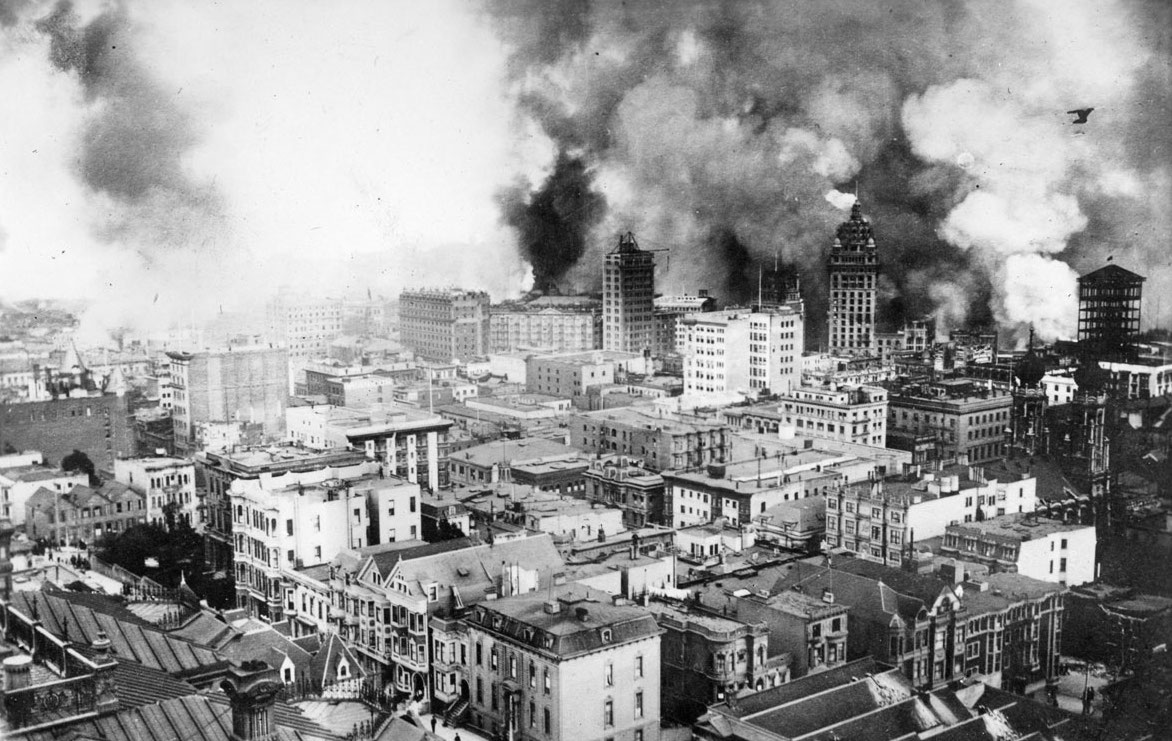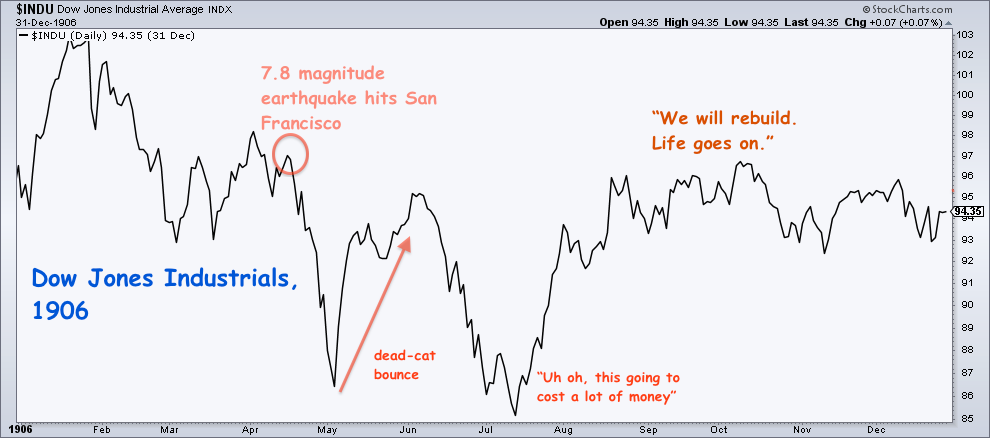One hundred and ten years ago…
Courtesy of Joshua M. Brown, The Reformed Broker

At eight o’clock in the morning of Wednesday April 18th 1906, Jesse Livermore was sound asleep in his New York hotel room after arriving back late from Palm Beach the previous evening.
3000 miles away, across the country in California, it was five o’clock in the morning and the city of San Francisco slept contentedly. Barely two minutes later, the earth shook and all 410,000 citizens were awoken as the San Andreas Fault suddenly ruptured. There were two quakes. The initial quake was hardly noticeable but, 20 seconds later, the earth tremored for 42 seconds at force eight, just about as bad as it gets. It shattered the surface of the earth for a length of 296 miles across California. At its epicentre, the ground moved 28 feet.
The above account of the infamous San Francisco quake comes from the book Jesse Livermore – Boy Plunger. Livermore had previously sold short 5000 shares of the Union Pacific railroad on a hunch that something bad was about to happen during a vacation in Florida. This was a massive trade for the speculator, given that he’d just spent the previous four years frittering around with small wins and losses, and focused more on his social life than on his career.
But Jesse’s gut told him to act that day in early April 1906…
Livermore just stood very still and quiet. He could feel something happening inside his head, a sensation he had not experienced before…Livermore was struck by a sudden impulse to do something based on nothing at all.
“I was looking over the quotation board, noting the changes, and they were mostly advances – until I came to Union Pacific and I got a feeling that I ought to sell it. I can’t tell you anymore. I just felt like selling it. I asked myself why I should feel like that and I couldn’t find any reason at all for going short of Union Pacific.”
He starts with a thousand shares short in the Florida branch of his friend’s brokerage firm, E.F. Hutton, and then gradually builds up his position while returning to New York. The next day, the quake hits and within a few days Livermore is sitting in profits on his leveraged bets. Union Pacific shares collapsed as it became apparent that shipping in and out of the region would be severely hampered, along with the potential for a US recession arising as a result of risk-averse business activity.
If this sounds familiar, it should.
The Brexit vote and its aftermath hit global currency, stock and bond markets much like the San Francisco earthquake did – the destruction was sudden and terrible. Banks across Europe and the UK are the epicentre while the ripple effects are happening in virtually every category of equity, commodity, fixed income or forex trade.
The immediate consequence of Brexit is that all manner of global trade may now be in flux. Decisions, relationships and long-term investments may be threatened as the players rethink their risk appetites, positioning and priorities. You can see this most acutely in financial stocks, airlines and industrials – the selling in these areas is relentless.
This selling may prove to have been overdone, and a bounce could happen at any time. But from what level and over what duration?
Because the more important consequences – the longer lasting ones – are only now being pondered by the masses. Is Brexit merely the first misguided populist quake in a series that will play out across the continent? Can the banking system withstand the volatility and the shifts in attitude toward risk? Has the UK inadvertently voted for recession? Can a recession be contained given the interconnectedness of the modern global economy? Is $2 trillion worth of losses the right amount for markets to have experienced, or not enough?
These are unanswerable questions at the moment. Opinions abound. In the absence of there being a serious plan in place for the Leave vote to prevail, Britain now faces an abyss of unknowing. She drags the world into that abyss with her, as stock market correlations snap to the vicissitudes of the Great British Pound.
The initial reports out of San Francisco on the days following the quake say that hundreds have died. By April 25th 1906, the market hits its low, with a billion dollars in value wiped out. And then it begins to recover.
But Livermore believes the newspapers are underreporting the tragedy. He quadruples his short to 20,000 shares of Union Pacific, with $3.5 million on the line, much of it borrowed from the brokerage firm.
The initial damage from the quake pales in comparison with what will happen in the aftermath. San Francisco is the 9th largest city in America at the time, and around a quarter of the buildings collapsed from the tremors, leaving 100,000 people homeless immediately.
By the next day, almost the entire city catches on fire.
The fire department is leaderless and the water mains are too damaged to help. Gas mains, meanwhile, are exploding and the city’s mostly wooden edifices go up like kindling. Panicked citizens make things worse. There is an attempt to create firebreaks using dynamite to contain the burning, but this only sets off more fires. Additionally, because the insurance policies of the day only covered fire damage and not earthquakes, people begin to set their own dwellings and properties ablaze.
It is estimated that some 80% of San Francisco’s buildings had been burnt to the ground when all was over, with more than 3000 people dead and a quarter of a million citizens homeless. It is the worst natural disaster in the history of California and, arguably, the United States.
When the dead-cat bounce in the stock market fades and rolls over that spring, the Boy Plunger finds himself with $250,000 in gains, an enormous windfall from stock speculation at the turn of the century. He covers his short into the second sell-off as the world realizes how bad the destruction actually is. The estimates for losses caused, to be borne by the nation’s largest insurance companies, total $400 million – an astonishing sum.
By the height of summer, Livermore is playing the true market recovery, which doesn’t begin until the end of July. He is now extremely long shares of Union Pacific, betting on its rise, as his brokers scream at him that he is crazy. The chronology looks like this:
Back to 2016 – We have seen our geopolitical earthquake and the damage from the initial tremors across financial markets. What we have not yet seen is the dead-cat bounce, where the optimistic decide that more is being made of the event than is necessary.
After this initial bounce, investors will then concern themselves with the more intermediate-term issues about whether or not a recession will be triggered, and what this means for the multiples of risk assets and the potential for earnings growth in general around the world. The force of these next-level concerns will likely serve as a ceiling for the bounce and may even drive us to revisit the recent lows, if the earthquake analog holds.
If Brexit does, in fact, resemble the unleashing of an earthquake, then patience will be the opportunistic investor’s biggest virtue now, not boldness.
One hundred and ten years ago this summer, an earthquake shocked the country. There was a panic, then a bounce, then a depressing reality set in and the bounce was gone.
And then, after all illusions about the cost of the event were dispelled – and only after – could the markets recover anew.




